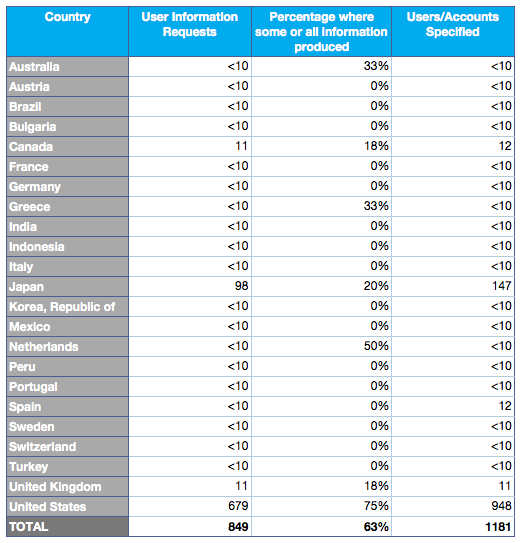Privacy advocates and security experts often warn users about the consequences of handing over so much of their personal data to Web sites or social networks, saying that they never know how it’s going to be used or sold. But it’s rare that users ever see examples of that in action. Twitter is giving people that chance with its decision to begin releasing reports on law enforcement requests for user data and content takedowns.
The first so-called transparency report from Twitter reveals that the service is the recipient of hundreds of requests from law enforcement agencies around the world each year, the vast majority of them from the United States. Law enforcement agencies in the U.S. sent 679 requests for user information to Twitter in the first six months of this year, more than six times as many as from the next most-active country, Japan. The company produced some or all of the information requested by U.S. agencies 75 percent of the time.
While the company complied with the large majority of requests from the U.S. authorities, Twitter refused all of the requests from 16 countries, including Brazil, Germany and Italy.
The Twitter Transparency Report, which follows on similar reports from Google, provides an interesting, but small, window into the kind of requests for data that the company sees every day. While the report breaks out the requests by country, it doesn’t specify exactly what kind of data law enforcement agencies are looking for on users. Twitter does, however, inform users when it receives a request for their data, unless the company is prohibited from doing so by law.
“One of our goals is to grow Twitter in a way that makes us proud. This ideal informs many of our policies and guides us in making difficult decisions. One example is our long-standing policy to proactively notify users of requests for their account information unless we’re prohibited by law; another example is transmitting DMCA takedown notices and requests to withhold content to Chilling Effects. These policies help inform people, increase awareness and hold all involved parties––including ourselves––more accountable; the release of our first Transparency Report aims to further these ambitions,” the company said.

User information requests may be the most interesting kind of request for most people, but there also are several other kinds of requests that the company receives. For example, companies often ask Twitter to remove certain kinds of content from the site, things like copyrighted content. In just the first six months of 2012, Twitter received more than 3,000 takedown requests of that kind and complied with 38 percent of them.
How companies such as Twitter and Google that collect large amounts of user data handle that information and to whom they turn it over is of vital interest to users. Once the data is in the hands of these companies, it’s out of the user’s control and they almost never have the ability to find out how’s it’s stored or used. Whether the publication of this kind of data by Twitter, Google and others will change how the companies actually use the information or how they respond to law enforcement remains to be seen.









